|
Wudu Patterns for Henna and Fingernails How to Henna Your Fingernails 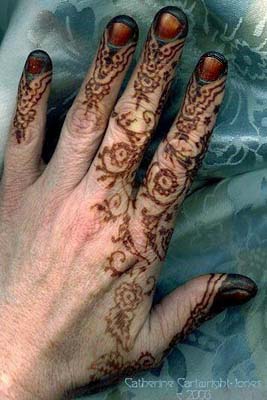 Some of the oldest and most widespread henna applications are
those for fingernails. Fingernails consist of keratin, the same
protein material as skin and hair, so henna stains fingernails in the
same way as it does skin or hair. Henna strengthens fingernails
and cuticles by binding to the keratin strands. Henna also deters
fungal infections of the nails. These qualities were important to
women who did hard agricultural work in soggy irrigated fields,
grinding grain and other household tasks, yet had to keep their
fingertips smooth for weaving and sewing, or who simply wanted to look
nice and not suffer from split nails and cuticles. Egyptian mummies from the early
Egyptian dynasties have darkened fingernails consistent with henna
application, though there were no representations of living people with
hennaed fingertips prior to the New Kingdom. Henna would have
kept mummies' fingertips supple, so the skin would not withdraw back
from the fingernails and retain a lifelike appearance, and would have
deterred fungal blooms which spoil preservation. From the New
Kingdom period on, the songstresses of Amun-Re are depicted with
hennaed nails. This can be seen in the mummy board of a
Songstress of Amun-Re from Thebes, 1050 BCE, in the British Museum,
London. Other Egyptian women and men are depicted with uncolored
nails through the New Kingdom period.
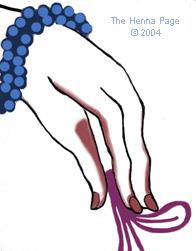 Hennaed palms and nails: “Lustral Basin”, North Wall, Adorants, Xeste 3, Akrotiri, prior to 1640 BCE, drawn from high resolution scan The women of the Minoan world
hennaed their nails as seen on the fresco “Mistress of Animals” and
Crocus Gatherer, Room e3 a, first floor, North Wall, and in “Lustral
Basin”, North Wall, Adorants, Xeste 3, at Akrotiri, dated prior to the
eruption of Thera in the first half of the second millennium
BCE. Cycladic, Mycenaean, and Cypriot figures of women from
that period also show women with hennaed nails.
Women hennaed their nails for two festivals in the Bronze Age eastern Mediterranean. One festival was in late March or early April, part of a fertility festival coinciding with the end of the rainy season and the beginning of the long summer drought. The second occasion was the end of the drought and beginning of the winter rains. The tableau from Xeste 3 seems to be a depiction of this spring festival.
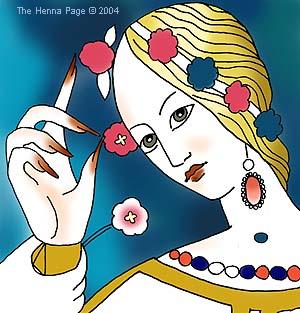 Woman with hennaed nails from Caceria, painting on leather ceiling of the Sala de los Reyes, late 14th c Palacio de la Alhambra, Granada drawn from high resolution scan Christian women in Medieval Spain
also hennaed their fingernails, as can be seen on the ceiling of the
Alhambra. Christian saints, depicted in medieval Spanish
manuscripts such as Beatus of Fernando I, c 1047, Valladolid Beatus c
970, and Biblia Primera Leon c 920, also have hennaed fingernails. Women in Spain continued to henna
their nails until 1526 when henna was made illegal in the Edict of
Granada, as a part of anti-Jewish and anti-Muslim legislation.
Mari Gomez la Sazeda successfully protested the law and overturned the
ruling in court. However, in 1530, the Bishop of Gaudix
complained to the chancellery of Granada that his female parishioners
were wearing henna. At this point, the ruling was adapted to
specify that if a woman hennaed, she could be arrested and tortured to
determine whether the henna was being used as a part of Jewish or
Muslim practice, such as a wedding, circumcision, bath, or Id. If
she was convicted of using henna in a heretical act, she was put to
death, but if she could prove that she used henna only for appearance,
she was released. On January 1, 1567, the Edict of Granada
outlawed henna without exception. ( Lea )
Lan Na 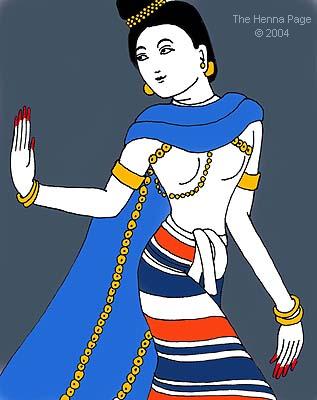 Princess from temple fresco, Wat Phumin, Nan, early 19th century drawn from high resolution scan, showing hennaed fingernails Lan Na princesses cultivated
extremely long hennaed fingernails, depicted in temple paintings in the
late eighteenth and early nineteenth centuries. Lower classes of
women in these paintings did not have long nails, nor were their nails
hennaed. Photographs and color portraits of women in the late
nineteenth century show only princesses with long hennaed nails.
Other women had short nails, and their fingers are often stained with
indigo from weaving and dying work. 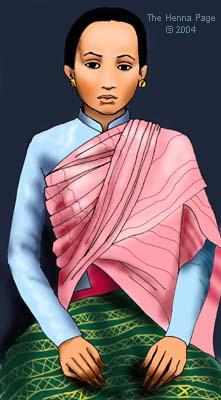 Princess Tipkesorn, Chiang Mai drawn from high resolution scan of late 19th century court portrait, showing long hennaed fingernails Several groups of Lan Na men tattooed their thighs, torsos and arms and some women tattooed their breasts, but there is no clear evidence that they wore patterned henna beyond their fingertips.
Women throughout the Muslim world
for the last 1500 years have been depicted with hennaed nails, though
their nails are clipped short. The rules for cleanliness, as
outlined by the Prophet Mohamed, strongly recommends trimming
fingernails very short, so fingertips can be kept clean for prayer, and
to prevent filth under the nails coming in contact with food. Men
are infrequently depicted with hennaed nails.
Abu Hurairah reported: The Prophet said, "There are five acts which conform to the pure nature: Circumcision, removing of the pubic hair, clipping the nails, plucking the underarm hair and trimming the mustache.'' (Al-Bukhar ) Mohamed recommended that women henna their nails: “ A woman made a sign from behind a curtain to indicate that she had a letter for the Apostle of Allah. The Prophet closed his hand, saying: I do not know this is a man's or a woman's hand. She said: No, a woman. He said: If you were a woman, you would make a difference to your nails, meaning with henna.” (Sunan Abu Dawud, 33: 4154: Aisha, Ummul Mu'minin). The correct cleansing of hands and nails is called "Wudu". For more information on Wudu go HERE!
Henna is the only fingernail
colorant approved by Orthodox Judaism because hands can be completely
cleaned for prayer. Regular fingernail polish creates a barrier
between cleansing water and the nail surface, so complete purification
is impossible. Both Islam and Sephardic Orthodox Judaism
recognize that women may henna fingernails and still be purified for
prayer.
In many cultures, women henna
their fingernails and feet before giving birth. This practice
often perplexes western-trained physicians, who use a pulse oximeter
clipped a thumbnail to monitor hemoglobin oxygen saturation levels when
a patient is under anesthesia. Regular fingernail polish blocks
these readings, and sometimes a nurse will be assigned the impossible
task of trying to remove henna from the fingernails with fingernail
polish remover. However, henna does not interfere with pulse
oximetry readings, as established by testing in a controlled study by
Al-Majed and Harakati in King Khalid University Hospital, Riyadh, Saudi
Arabia, and Hameedullah; Rauf MA; Khan FA, Dept. of Anesthesiology, The
Aga Khan University Hospital, Karachi, Pakistan. Women do not
need to abandon their practice of hennaing for birth, or be concerned
that hennaed nails would interfere with other health care.
Reference: al-Majed SA, Harakati, MS. The effect of henna paste on oxygen saturation reading obtained by pulse oximetry. Trop Geogr Med 1994;46(1);38-39. Online references for Hennaed Fingernails and Anesthesiology http://medind.nic.in/imvw/imvw528.html Henna and Pulse Oximetry: al-Majed and Harakati Other Refences for this Page: Susan Conway, 2002 The Moriscos of Spain, Their Conversion and Expulsion Burt Franklin New York Doumas, C; tr. Doumas, A. The Wall Paintings of Thera The Thera Foundation, Athens 1992 Abu-Dawud, S. Hadith Collection Mentre, M. 1996 Illuminated Manuscripts of Medieval Spain Thames and Hudson Smith, B., Spain, A History in Art Doubleday Can't find what you're looking for? Try: The Henna Page Main Index http://www.hennapage.com/henna/mainindex.html *"Henna,
the
Joyous Body Art"
the Encyclopedia of Henna Catherine Cartwright-Jones c 2000 registered with the US Library of Congress TXu 952-968 |